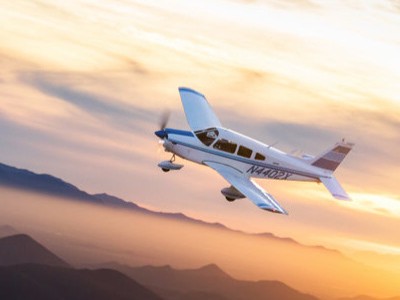The Federal Aviation Authority (FAA) broadly groups pilots into non-commercial and commercial categories. Amongst other pilot classifications under the non-commercial category are private and recreational pilots. While recreational pilots and private pilots both fly non-commercial aircraft, several differences set these pilot classifications apart from each other.
In this article, we’ll explain these differences to help you choose which classification works best for you based on the type of pilot you wish to become.
Who is a Recreational Pilot?
A recreational pilot owns a recreational pilot license. This license allows the pilot to fly as Pilot in Command (PIC) in a single-engine aircraft with a maximum of 180 horsepower for leisure and pleasure. A recreational pilot usually flies within 50 nautical miles of the departure airport and can carry only one passenger.
Who is a Private Pilot?
Not to be confused with a commercial pilot, a private pilot owns a license that certifies them to fly as PIC in non-commercial aircraft across countries and nearly every airspace class. A private pilot can fly solo or with passengers, but typically, they cannot carry passengers for hire or compensation.
What is the Difference Between A Recreation Pilot and a Private Pilot?
The primary difference between recreational and private pilots is their certification type. Typically, you must have a recreational pilot license (RPL) to be a recreational pilot, and you must hold a private pilot license (PPL) to be a private pilot.
Recreational and private pilots exercise different privileges, and the requirements for obtaining these certificates also differ. In the next section, we will discuss the differences between recreational and private pilots by breaking down the differences between both licenses.
Recreational Pilot License: Requirements, Privileges, and Limitations
To earn the privileges of a recreational pilot license, aspiring pilots must meet specific requirements and respect the limitations of an RPL. Let’s take a look at each of these in turn.
Recreational Pilot License Requirements
To receive a recreational pilot license, aspiring pilots must meet the following requirements set by the FAA to obtain their license:
- Must be at least 17 years of age or 16 for a rating in a glider or balloon.
- Must be able to read, write, and understand English
- Has to pass the written and practical FAA exams.
- Has to hold either a student pilot or sport pilot certificate.
- Must log at least 30 hours of flight time, including at least 15 hours of flight training from an authorized instructor and three hours of solo flying in the aircraft for the rating sought.
- Must hold a third-class medical certificate.
Recreational Pilot License Privileges
Once an individual becomes a certified recreational pilot, their license affords them specific privileges allowing them to act as PIC of an aircraft. These privileges include
- In Class B, C, and D airspace.
- Carrying one passenger.
- A single-engine aircraft of 180 horsepower or less.
- On a flight within 50 nautical miles from the departure airport.
Recreational Pilot License Limitations
Likewise, recreational pilots must respect strict limitations when they cannot act as PICs in an aircraft. These limitations include:
- Carrying more than one passenger.
- On a flight that exceeds 50 nautical miles from the departure airport, except if they have been trained and endorsed in cross-country flights by an authorized instructor.
- Certificated for more than four occupants, with multi-engine or a single engine of more than 180 hp (except certified in the rotorcraft category), or with retractable gear.
- Carrying a passenger or property for hire or compensation to further a business in a passenger-carrying airlift sponsored by a charitable organization or an aircraft towing an object.
- Between sunset and sunrise.
- At an altitude of more than 10,000 feet MSL or 2,000 feet AGL, whichever is higher.
- When the flight or surface visibility is less than three statute miles.
- Without visual reference to the surface.
Private Pilot License: Requirements, Privileges, and Limitations
Similar to an RPL, aspiring private pilots must earn the privileges of a PPL by meeting specific requirements and respecting the limitations of this license. Let’s take a look.
Private Pilot License Requirements
To become receive a private pilot license, aspiring pilots must meet the following requirements set by the FAA to obtain a PPL:
- Be at least 17 years of age or at least 16 for a rating in a glider or balloon.
- Must be able to read, speak, write, and understand English
- Pass the practical test for the aircraft rating sought.
- Hold a student pilot, sport pilot, or recreational pilot certificate.
- Log at least 40 hours of flight time, including at least 20 hours of flight training from an authorized instructor and 10 hours of solo flight.
- Hold a third-class medical certificate or BasicMed.
Private Pilot License Privileges
After receiving their private pilot certification, pilots are afforded several privileges that allow them to act as PICs of an aircraft. These privileges include the following:
- The right to carry several passengers
- The privilege of flying at night
- The ability to fly out of all public airports in all airspace classes except Class A unless they have an instrument flight rating.
- Allowance to act as PIC for tow gliders and unpowered ultralight vehicles
- The opportunity to perform cross-country flights.
Private Pilot License Limitations
A private pilot cannot carry passengers or cargo for compensation or hire as PIC in an aircraft. However, several exceptions exist, including flying for charitable, non-profit, or community events.
A private pilot may also be reimbursed for aircraft operating expenses directly related to search and location operations controlled by a local, state, or federal agency or a search and location operations organization.
Do You Need a Recreational Pilot License or a Private Pilot License?
Choosing between a recreational pilot or private pilot license will depend on the type of flight operation you want to carry out. Recreational pilots can only fly for fun, carrying only one passenger. As such, many limitations exist to how far and the type of aircraft they are allowed to fly. Private pilots can carry more passengers, go on cross-country flights, and operate small multi-engine aircraft. Also, they may fly for compensation or hire under some conditions.
Once you’ve chosen the best license for the flying you wish to do, we invite you to contact Sunset Aviation Insurance to find a suitable insurance policy to protect you, your passengers, and your aircraft once you’re in flight.

Benjamin Peterson
Graduated from the University of North Dakota with a degree in Commercial Aviation as a Pilot and Flight Instructor. My first professional job was working for Cirrus Aircraft as an instructor.
